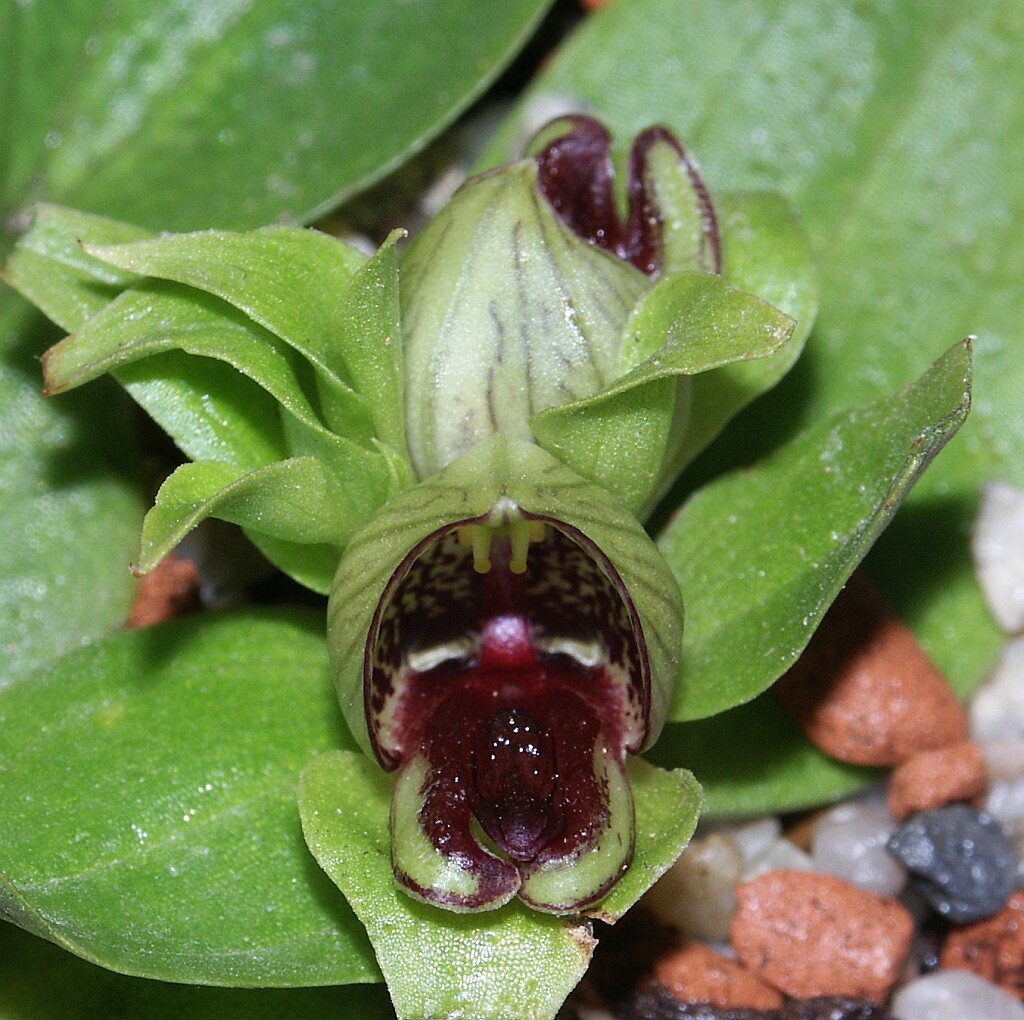Satyrium pumilum Photo by Bernd Haynold licensed by CC BY-SA 3.0
Orchids are really good at tricking pollinators. Take, for instance, this strange looking orchid from South Africa. Satyrium pumilum is probably obscure to most of us but it is doing fascinating things to ensure its own reproductive success. This orchid both smells and kind of looks like rotting meat, which is how it attracts its pollinators.
It is a bit strange to think of orchids living in arid climates like those found in South Africa but this family is defined by exceptions. That is not to say that Satyrium pumilum is a desert plant. To find this orchid, you must look in special microclimates where water sticks around long enough to support its growth. Populations of S. pumilum are most often found clustered near small streams or hidden under bushes throughout the western half of the greater Cape Floristic Region.
Satyrium pumilum blooms from the beginning of September until late October. As is typical in the orchid family, S. pumilum produces rather intricate flowers. Whereas the sepals are decked out in various shades of green, the interior of the flower is blood red in color. Also, unlike many of its cousins, S. pumilum doesn’t throw its flowers up on a tall stalk for all the world to see. Instead, its flowers open up at ground level and give off an unpleasant smell of rotting meat.
This is where pollinators enter into the picture. It has been found that carrion flies are the preferred pollinator for S. pumilum. By producing flowers at ground level that both look and smell like rotting meat, the plants are primed to attract these flies. The plants are tapping into the flies’ reproductive habits, a biological imperative so strong that they simply do not evolve a means of discriminating a rotting corpse from a flower that smells like one. This is the trick. Flies land on the flower thinking they have found a meal and a place to lay their eggs. They go through the motions as expected and pick up or deposit pollen in the process. Unfortunately for the flies, their offspring are doomed. There is not food to be found in these flowers.
What is most remarkable about the reproductive ecology of S. pumilum is that not just any type of fly will do. It appears that only a specific subset of flies actually visit the flowers and act as effective pollinators. Amazingly, this provides insights into some long-running hypotheses regarding carrion fly ecology.
(A) The habitat of S. pumilum (B) Satyrium pumilum in situ (scale bar = 1 cm). (C–E) Pollination sequence of a S. pumilum flower by a sarcophagid fly in an arena (scale bar for all three photos = 0·5 cm); (C) the fly carrying five pollinaria from other S. pumilum flowers enters an unpollinated flower (D) as the fly moves deeper into the flower towards the right-hand spur, it presses an attached pollinium against the stigma, and its thorax against the right-hand viscidium; (E) as it leaves the flower, the fly has deposited two massulae on the stigma (1), and removed a pollinarium (2) – it now carries six pollinaria. [SOURCE]
Apparently there has been a lot of debate in the fly community over why we see so many different species of carrion flies. Rotting meat is rotting meat, right? Probably not, actually. Fly ecologists have comes up with a few hypotheses involving niche segregation among carrion flies to explain their diversity on the landscape. Some believe that flies separate themselves out in time, with different species hatching out and breeding at different times of the year. Others have suggested that carrion flies separate themselves by specializing on carrion at different stages of decay. Still others have suggested that some flies specialize on large pieces of carrion whereas others prefer smaller pieces.
By studying the types of flies visiting the flowers of S. pumilum researchers did find evidence of niche segregation based on carrion size. It turns out that S. pumilum is exclusively pollinated by a group of flies known as sarcophagid carrion flies. These flies were regularly observed with orchid pollen sacs stuck to their backs and plants seemed to only set seed after they had been visited by members of this group. So, what is it about these flowers that makes them so specific to this group of flies?
The answer lies both in their size as well as the amount of scent they produce. It is likely that the quantity of scent compounds produced by S. pumilum most closely mimics that of smaller rotting corpses. The types of flies that visited these blooms were mostly females of species that lay relatively few eggs compared to other carrion flies. It could very well be that the smaller brood size of these flies allows them to effectively utilize smaller bits of carrion than other, more fecund species of fly. To date, this is some of the best evidence in support of the idea that flies avoid competition among different species by segregating out their feeding and reproductive niches.
Rotting meat smells are not uncommon in the plant world. Even within the home range of S. pumilum, there are other plants produce flowers that smell like carrion as well. It would be extremely interesting to look at what kinds of flies visit other carrion flowers and in what numbers. Like I mentioned earlier, reproductive is such a major part of any organisms life that it may simply be too costly for carrion flies to evolve a means of discriminating real and fake breeding sites. It is amazing to think of what we gain from trying to understand the reproductive biology of a small, obscure orchid growing tucked away in arid regions of South Africa.
Further Reading: [1]


![[SOURCE]](https://images.squarespace-cdn.com/content/v1/544591e6e4b0135285aeb5b6/1510771591218-E7STZ1TS2LEW7CZUCQFX/nph14859-fig-0001.png)